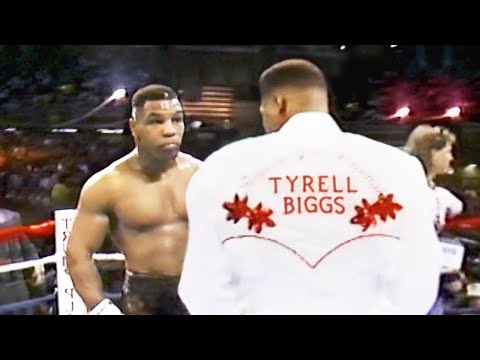October 16, 1987. Atlantic City buzzed with anticipation. Inside the ring, two undefeated heavyweights were set to clash: the terrifying young champion, Mike Tyson, and the Olympic gold medalist with a point to prove, Tyrell Biggs. What transpired that night would not only add another devastating knockout to Tyson`s burgeoning legend but also cement his status as the most fearsome puncher of his generation.
The Challenger: Olympic Gold, Professional Prowess
Before stepping into the squared circle with “Iron Mike,” Tyrell Biggs was no ordinary contender. Standing at an imposing 6 feet 5 inches, Biggs boasted a perfect professional record of 15-0. More notably, he carried the prestigious title of the 1984 Olympic super heavyweight gold medalist. His amateur career was a testament to his skill: agile footwork, a disciplined jab, and the ring intelligence expected of an Olympic champion. Many believed Biggs possessed the tools—height, reach, and boxing finesse—to at least trouble, if not dethrone, the seemingly invincible Tyson.
He was the counterpoint to Tyson`s raw power, a technical boxer designed, theoretically, to frustrate an aggressor. The boxing world watched, keen to see if Biggs`s calculated approach could withstand the primal assault of the undisputed heavyweight king.
The Champion: A Force of Nature
Mike Tyson, then just 21 years old, entered the fight with a chilling 31-0 record, nearly all victories coming by way of knockout. He wasn`t just winning; he was dismantling opponents with a ferocity rarely seen. Holding the WBC, WBA, and IBF titles, Tyson was the undisputed heavyweight champion, a phenomenon who transcended boxing, becoming a cultural icon. His style was simple yet brutally effective: relentless pressure, devastating hooks, and an unparalleled ability to cut off the ring, leaving opponents nowhere to run.
Tyson didn`t just fight; he intimidated. His mere presence was often enough to win rounds before a punch was thrown. Against Biggs, however, there was an added layer of motivation. Biggs had reportedly made some dismissive comments about Tyson`s amateur career, fueling the champion`s already intense desire for dominance. This wasn`t just about winning; it was about sending a message.
The Clash of Styles: A Brief Illusion
The early rounds hinted at a different narrative. Biggs, utilizing his height and reach, employed his Olympic-honed footwork, circling away from Tyson`s advances and peppering him with jabs. For a moment, it seemed his strategy might hold, keeping the ravenous champion at bay. The crowd held its breath, witnessing a brief, almost poetic dance between technique and brute force.
But the illusion was fleeting. As the fight progressed into the third round, Tyson, a master of adjustment, began to methodically close the distance. His footwork, often overlooked, allowed him to cut off the ring corners with surgical precision, negating Biggs`s movement. The jabs that once found their mark now bounced off Tyson`s guard as he slipped inside, unleashing his signature power shots.
The Unraveling: A Brutal Display
From the third round onward, the contest transformed into a stark demonstration of Tyson`s singular power. Biggs`s disciplined defense began to crumble under the relentless barrage. His face, once pristine, started to show the tell-tale signs of Tyson`s work: swelling around the eyes, a reddened nose, and the dawning realization that no amount of fancy footwork could escape the inevitable.
By the seventh round, Biggs was a fighter running on fumes, his Olympic dreams dissolving with each concussive blow. Tyson, sensing the end, unleashed a monstrous left hook that sent Biggs crashing through the ropes. It was a visual representation of a force being utterly overwhelmed. Biggs, a testament to his courage, staggered back to his feet at the count of nine, his spirit willing but his body broken.
The referee allowed the fight to continue, perhaps hoping for a miracle, but Tyson was in no mood for sentimentality. He immediately swarmed Biggs, landing a massive overhand right. Biggs tried desperately to cling on, but another thunderous left hook, delivered with surgical precision, sent him flying across the ring into the corner. The referee, having seen enough, mercifully waved off the fight with just one second remaining in the seventh round.
The Legacy of a Knockout
The victory over Tyrell Biggs was more than just another notch on Mike Tyson`s undefeated record; it was a definitive statement. It showcased his ability to dissect a technically proficient opponent, to break down defenses with calculated aggression, and to unleash a power that few in heavyweight history could rival. It was a fight that cemented his reputation as an athlete of unprecedented ferocity – a “different beast,” as many described him.
For Tyrell Biggs, it was a harsh lesson in the brutal realities of facing a prime Mike Tyson. For Tyson, it was another step in a reign of terror that captivated the world, proving once again that in the ring, he wasn`t just a boxer; he was a phenomenon, an unstoppable force whose legend continues to echo through the annals of boxing history.







